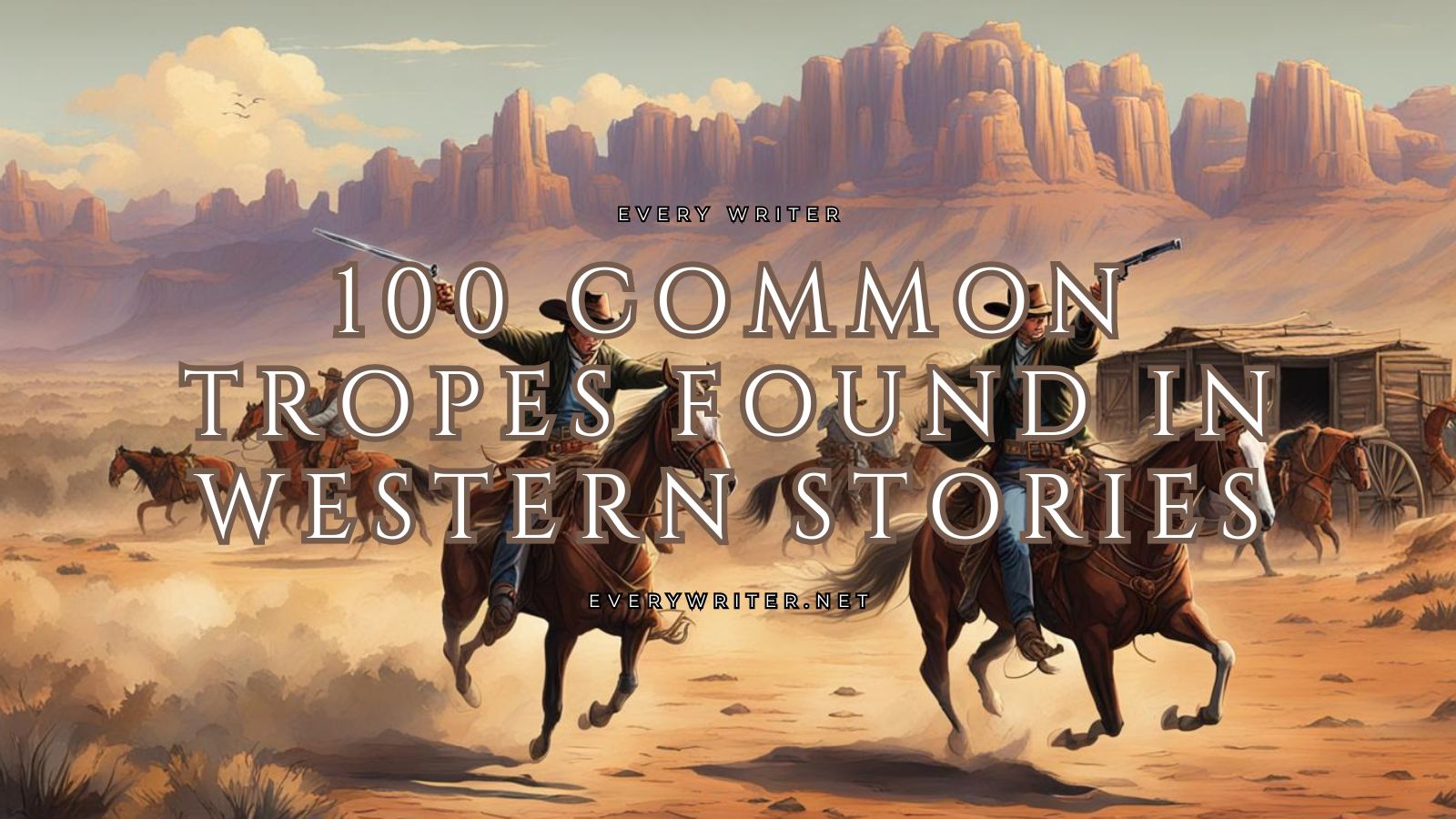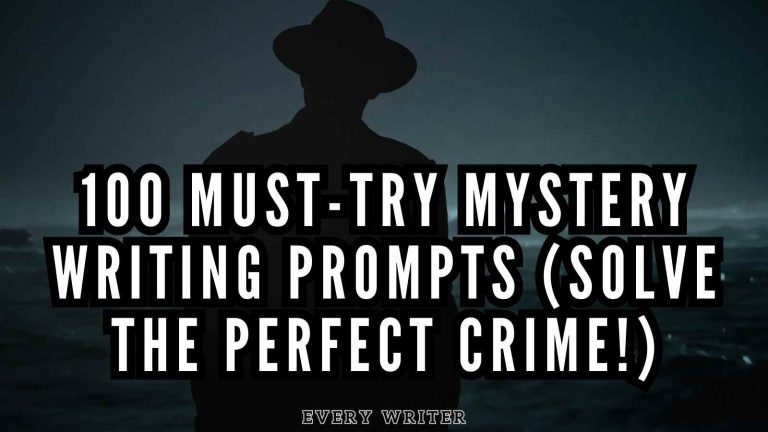
Here are 100 common tropes found in Western stories: The Western genre has captivated audiences for over a century, transporting viewers to a time of untamed frontiers, rugged heroes, and the eternal struggle between good and evil. From the earliest days of cinema, with silent films like “The Great Train Robbery” (1903), to the golden age of Hollywood, where stars like John Wayne and Gary Cooper brought the Old West to life, and on to the revisionist Westerns of the 1960s and ’70s, this genre has left an indelible mark on popular culture. The enduring appeal of the Western lies not only in its historical setting but also in the timeless themes and archetypal characters that have become synonymous with the genre.
At the heart of the Western are the tropes – the recurring themes, characters, and plot devices that have come to define the genre. These tropes serve as the building blocks of the Western, providing a familiar framework for storytellers to explore the myths and realities of the American frontier. From the lone cowboy hero and the damsel in distress to the evil cattle baron and the wise old Native American chief, these archetypes have become ingrained in our collective consciousness, shaping our understanding of the Old West and the values it represents.
Tropes are essential to the Western genre for several reasons. First, they provide a shorthand for storytelling, allowing writers and filmmakers to quickly establish characters and situations that audiences will recognize and understand. By tapping into these familiar elements, storytellers can efficiently convey complex ideas and emotions, while also subverting expectations for dramatic effect. Second, tropes help to create a sense of continuity and shared experience across different Western stories, reinforcing the genre’s identity and appeal. Finally, tropes serve as a reflection of the cultural values and anxieties of the times in which they were created, offering insight into the evolving attitudes and beliefs of American society.
The significance of Western tropes extends beyond the genre itself, influencing other forms of storytelling and popular culture. The iconic image of the lone hero standing up for justice, the importance of individual freedom and self-reliance, and the struggle between civilization and wilderness are themes that have resonated with audiences far beyond the Western’s traditional boundaries. From science fiction epics like “Star Wars” to post-apocalyptic tales like “The Walking Dead,” the influence of Western tropes can be seen in countless modern stories, testifying to the enduring power and relevance of the genre.
In the following list, we will explore 100 common tropes found in Western stories, examining their origins, their significance, and their lasting impact on popular culture. By understanding these tropes and their role in shaping the Western genre, we can gain a deeper appreciation for the stories that have captivated audiences for generations, and the enduring appeal of the American frontier in our collective imagination. As we delve into these iconic elements, we will see how the Western continues to evolve and adapt, reflecting the changing values and concerns of our society while remaining true to the timeless themes that have made it one of the most beloved and enduring genres in storytelling history.
Here are 100 common tropes found in Western stories:
- The lone cowboy hero: A rugged, independent protagonist who fights for justice and order in a lawless frontier.
- The damsel in distress: A female character who is often rescued by the hero from danger or peril.
- The evil cattle baron or land owner: A wealthy, corrupt antagonist who seeks to control the land and its resources.
- The saloon as a social hub: A gathering place for the town’s residents, where drinking, gambling, and socializing occur.
- The showdown at high noon: A climactic confrontation between the hero and the villain, usually taking place at midday.
- The quick-draw duel: A face-to-face gunfight where the fastest draw wins.
- The faithful horse companion: The hero’s loyal steed, often playing a crucial role in their adventures.
- The Native American raid: Depictions of Native American tribes attacking settlers or frontier towns.
- The gold rush and prospecting: Stories centered around the search for gold and the ensuing chaos and competition.
- The stagecoach journey: Characters traveling across the frontier by stagecoach, often facing dangers along the way.
- The bank robbery: Outlaws attempting to steal from a town’s bank, usually leading to a confrontation with the hero.
- The train heist: Robbers attacking and looting a train, often with the hero intervening to stop them.
- The wanted poster: A notice displaying the image and crimes of a wanted outlaw, promising a reward for their capture.
- The hanging judge: A strict, uncompromising judge who readily sentences criminals to death by hanging.
- The frontier doctor: A medical professional who tends to the health needs of the frontier community.
- The preacher with a dark past: A religious figure who has a secretive, often violent history.
- The prostitute with a heart of gold: A kind-hearted sex worker who assists the hero or plays a pivotal role in the story.
- The greenhorn from the East: An inexperienced, naive character from the civilized East who must adapt to the rough frontier.
- The wise old Native American chief: A respected, elder Native American leader who offers guidance or assistance to the hero.
- The corrupt sheriff: A law enforcement official who abuses their power for personal gain.
- The bounty hunter: A skilled tracker who pursues wanted criminals for monetary rewards.
- The cattle drive: The process of moving a large herd of cattle across the frontier to market.
- The campfire scene: Characters gather around a fire at night, sharing stories, meals, or planning their next move.
- The ghost town: An abandoned frontier settlement, often with a mysterious or haunted past.
- The outlaw gang: A group of criminals who work together to commit crimes and evade the law.
- The frontier fort: A military outpost on the frontier, often serving as a refuge or base of operations.
- The buffalo hunt: Scenes depicting the hunting of buffalo, either for food, hides, or sport.
- The cavalry charge: Military horsemen riding to the rescue or engaging in battle.
- The telegraph office: A communication hub where messages are sent and received over long distances.
- The Pony Express rider: A horseback messenger who carries mail across the frontier.
- The frontier wedding: A marriage ceremony taking place in a frontier setting, often with unique customs.
- The wanted outlaw seeking redemption: A criminal protagonist seeking to atone for their past misdeeds.
- The marshal upholding the law: A dedicated law enforcement officer working to maintain order on the frontier.
- The frontier funeral: A burial ceremony in a frontier setting, often marked by simplicity and solemnity.
- The saloon brawl: A physical fight breaking out in the saloon, often involving the hero.
- The card game with high stakes: Characters engage in a tense game of poker or other card games, often with significant consequences.
- The frontier trial: A legal proceeding in a frontier court, often with the hero acting as a defendant, witness, or advocate.
- The pioneer wagon train: A group of settlers traveling together in covered wagons across the frontier.
- The claim jumper: A character who illegally tries to take over another person’s land claim.
- The range war: A conflict between rival ranchers or landowners over control of land and resources.
- The cattle rustlers: Thieves who steal cattle from ranchers, often leading to pursuit by the hero.
- The desert crossing: Characters must traverse a harsh, arid landscape, facing challenges like thirst and heat.
- The mountain man: A rugged, independent trapper or explorer who lives in the wilderness.
- The frontier photographer: A character who captures images of the frontier, its people, and events.
- The traveling medicine show: A group of entertainers and salespeople who peddle dubious medical cures and treatments.
- The frontier journalist: A writer or reporter who covers news and events on the frontier.
- The singing cowboy: A hero who expresses himself through song, often with a guitar.
- The frontier blacksmith: A skilled metalworker who crafts and repairs tools, weapons, and horseshoes.
- The frontier seamstress: A woman who creates and mends clothing for the frontier community.
- The cattle branding scene: The process of marking livestock with a hot iron to identify ownership.
- The Native American tracker: A skilled Native American who assists the hero in following trails or finding people.
- The frontier barber: A character who provides grooming services and often serves as a source of local gossip.
- The stagecoach driver: A skilled horseman who navigates the stagecoach through dangerous territory.
- The frontier undertaker: A character responsible for preparing the deceased for burial and arranging funerals.
- The frontier schoolteacher: An educated individual who teaches children in a one-room schoolhouse.
- The wanted man’s hideout: A secret location where a fugitive hides from the law.
- The frontier storekeeper: The owner of the general store, providing supplies and goods to the community.
- The frontier saloonkeeper: The proprietor of the saloon, often a central figure in the town’s social life.
- The sharpshooting hero: A protagonist with exceptional skill in shooting, often able to make seemingly impossible shots.
- The saloon piano player: A musician who provides entertainment in the saloon, often playing upbeat tunes.
- The frontier barkeep: The bartender in the saloon, serving drinks and witnessing the town’s drama.
- The Native American ambush: An attack by Native Americans on unsuspecting travelers or settlers.
- The frontier stable: A place where horses are kept, rented, or sold.
- The campfire coffee scene: Characters bonding or discussing plans over coffee around a campfire.
- The saloon girl: A female employee of the saloon who provides entertainment and companionship to patrons.
- The frontier postmaster: The person responsible for handling mail and packages in the town.
- The stagecoach robbery: Outlaws attacking and robbing a stagecoach, often leading to a chase or confrontation.
- The quick-draw practice scene: The hero honing their shooting skills through target practice.
- The frontier revival meeting: A religious gathering led by a preacher, often held outdoors.
- The Native American peace pipe: A ceremonial tobacco pipe used in Native American rituals or negotiations.
- The frontier jailbreak: The hero or an ally escaping from the town’s jail, often with outside help.
- The campfire ghost story: Characters telling spooky tales around the campfire at night.
- The frontier mining camp: A settlement that springs up around a mining operation, often with a rough reputation.
- The saloon card sharp: A skilled card player who often cheats or swindles others in poker games.
- The frontier wedding celebration: A joyous gathering of the community to celebrate a couple’s marriage.
- The stagecoach way station: A rest stop along the stagecoach route where passengers can eat, rest, and change horses.
- The Native American captive: A white character, often a woman, taken captive by Native Americans.
- The frontier hanging tree: A tree used for executing criminals by hanging.
- The campfire singing scene: Characters singing folk songs or ballads around the campfire.
- The frontier telegraph operator: The person responsible for sending and receiving telegrams in the town.
- The saloon fight over a woman: Two men fighting in the saloon over the affections of a female character.
- The frontier cattle auction: The buying and selling of cattle, often a major event for ranchers.
- The stagecoach chase: Pursuers on horseback chasing after a fleeing stagecoach.
- The frontier circuit judge: A traveling judge who holds court in various towns along a route.
- The Native American burial ground: A sacred site where Native Americans bury their dead.
- The frontier barn dance: A social gathering featuring music, dancing, and courting rituals.
- The saloon poker tournament: A high-stakes poker competition held in the saloon.
- The frontier cattle rustling trial: A legal proceeding dealing with the theft of cattle.
- The stagecoach hold-up: Robbers stopping a stagecoach at gunpoint to steal valuables.
- The frontier medicine woman: A female healer who uses herbal remedies and traditional knowledge.
- The saloon drinking contest: Characters engage in a competition to consume the most alcohol.
- The frontier cattle stampede: A herd of cattle running wild, often causing damage or danger.
- The Native American vision quest: A spiritual journey undertaken by a Native American character for guidance or insight.
- The frontier shotgun wedding: A hasty marriage, often due to pregnancy, with the groom being coerced at gunpoint.
- The saloon showdown over cheating: A confrontation in the saloon over accusations of cheating during a card game.
- The frontier Fourth of July celebration: The town gathers to celebrate Independence Day with festivities and patriotic displays.
- The stagecoach river crossing: The stagecoach must ford a river, facing dangers like strong currents or slippery banks.
- The frontier mining claim dispute: A conflict between miners or prospectors over the ownership of a valuable claim.
- The saloon owner’s hidden past: The proprietor of the saloon has a secretive history that comes to light.
- The frontier canoe chase: Pursuers in canoes chasing after fugitives on a river or stream.
In exploring these 100 common tropes found in Western stories, we have seen how the genre has evolved and endured over time, reflecting the changing values and attitudes of American society while remaining true to its core themes and archetypes. From the earliest days of cinema to the present, the Western has served as a powerful lens through which we can examine our collective dreams, fears, and aspirations, offering insight into the complex and often contradictory nature of the American experience.
The tropes that define the Western genre are more than just storytelling devices; they are a reflection of our shared cultural heritage, a testament to the enduring power of myth and legend in shaping our understanding of the world. Whether it’s the lone cowboy hero standing up for justice, the struggle between civilization and wilderness, or the importance of individual freedom and self-reliance, these themes continue to resonate with audiences, speaking to the deepest yearnings and fears of the human spirit.
As we look to the future of the Western genre, it is clear that these tropes will continue to evolve and adapt, taking on new meanings and significance in response to the changing needs and concerns of our society. Just as the Western has served as a reflection of our past, so too will it serve as a guide and inspiration for our future, reminding us of the enduring values and ideals that have shaped our nation and our world.
In the end, the true power of the Western lies not in its historical accuracy or its adherence to a particular set of conventions, but in its ability to tell stories that speak to the human condition, that challenge us to confront our deepest fears and aspirations, and that celebrate the indomitable spirit of the human race. Whether we are watching a classic John Wayne film or a modern revisionist Western, we are participating in a shared cultural experience that connects us to our past, our present, and our future, and that reminds us of the enduring power of storytelling to shape our understanding of the world.
So let us continue to explore the rich and varied landscape of the Western genre, to celebrate its iconic tropes and archetypes, and to find new and meaningful ways to tell the stories that matter most to us. For as long as there are tales to be told and dreams to be dreamed, the Western will endure, a testament to the enduring power of the human imagination and the indomitable spirit of the American West. We have many more tropes on our site you may be interested in.
- 8 Authors Who Created Literary Masterpieces Keeping Their Day Jobs - March 31, 2025
- Plotter or Pantser? A Writer’s Personality Quiz - March 30, 2025
- 100 Must-Try Mystery Writing Prompts (Solve the Perfect Crime!) - March 22, 2025






